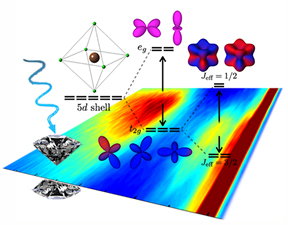Insulator-metal transitions (IMT), where a material changes from an insulator to a metal with substantially enhanced electrical conductivity, represent an important topic in contemporary condensed matter physics and an opening to a new field for synthesizing functional materials. An international team of researchers using the U.S. Department of Energy’s Advanced Photon Source (APS) at Argonne found that strontium iridium oxide, Sr3Ir2O7, undergoes just such an IMT and becomes a confined metal at high pressure, showing metallicity in the crystal ab-plane but insulating along the c-axis. Such unusual behavior resembles the strange metallic phase encountered in cuprate high-temperature superconductors.
5d transition-metal oxides are a new scientific frontier for studying exotic states of matter emerging from the interplay of spin-orbit coupling, electron interactions, and crystal field effects. Sr3Ir2O7 is a compound belonging to the Ruddlesden-Popper perovskite iridates Srn+1IrnO3n+1(where n is the number of SrIrO3 perovskite layers between extra SrO layers), and it is insulating at ambient condition. The relatively low electrical resistivity and small charge gap of Sr3Ir2O7 suggest that the material can undergo a potential IMT upon external perturbation, such as carrier doping, magnetic field, or external pressure. Among these choices, applying high pressure has been found to be a unique and direct tool in tuning a system’s interatomic distances and atomic arrangements.
In the present study, published in Physical Review Letters, the research team performed electric resistance and resonant inelastic x-ray scattering (RIXS) measurements at the X-ray Science Division 27-ID-B and 30-ID-B,C x-ray beamlines at the APS, which is an Office of Science user facility. They studied single-crystal Sr3Ir2O7 under high pressure, employing diamond anvil cell techniques. The resistance measurements indicated an IMT occurring at around 59 GPa, and the resulting high-pressure phase exhibited a novel confinement phenomenon: metallic behavior within the ab-plane, but an insulating one along the c-axis.
The discovery of a novel high-pressure metallic phase with intriguing confinement characteristics similar to those found in over-doped cuprate superconductors suggests that superconductivity could potentially be found in doped Sr3Ir2O7 under high pressure.
The totally unexpected but very intriguing behavior of Sr3Ir2O7 was observed for the first time under high pressure. The x-ray measurements show very robust spin-orbit- and electron-Coulomb interactions within the pressure range investigated, pointing to this newly-discovered transition from insulator to confined metal being potentially driven by a first-order structural phase transition reported by recent diffraction measurements.
“We will continue the study to even lower temperature- and higher pressure conditions to investigate the possibility of a metal-superconductor transition in perovskite iridates. We also will systematically study other 5d transition-metal compounds to investigate their electronic properties and discover exotic interesting physical properties,” said Yang Ding from the Center for High Pressure Science and Technology Advanced Research (China), lead author of the study.
See: Yang Ding1,2,3*, Liuxiang Yang1,3, Cheng-Chien Chen2,4, Heung-Sik Kim5, Myung Joon Han5, Wei Luo6, Zhenxing Feng2, Mary Upton2, Diego Casa2, Jungho Kim2, Thomas Gog2, Zhidan Zeng1,3, Gang Cao7, Ho-kwang Mao1,3, and Michel van Veenendaal2,10, “Pressure-Induced Confined Metal from the Mott Insulator Sr3Ir2O7,” Phys. Rev. Lett. 116, 216402 (2016). DOI: 10.1103/PhysRevLett.116.216402
Author affiliations: 1Center for High Pressure Science and Technology Advanced Research, 2Argonne National Laboratory, 3Carnegie Institution of Washington, 4University of Alabama, 5Korea Advanced Institute of Science and Technology, 6Uppsala University, 7University of Kentucky, 8Northern Illinois University
Correspondence: *yang.ding@hpstar.ac.cn
C.C.C. is supported by the Aneesur Rahman Postdoctoral Fellowship at Argonne. H.-S.K. and M.J.H. were supported by the Basic Science Research Program through NRF (Grant No. 2014R1A1A2057202) and by Samsung Advanced Institute of Technology. G.C. acknowledges National Science Foundation support via Grant No. DMR1265162. H.-k. M. acknowledges the support of the U.S. Department of Energy (DOE)-Basic Energy Sciences under Award No. DE-FG02-99ER45775 and NSFC Grant No. U1530402. M.v. V. is supported by the U.S. DOE under Award No. DE-FG02-03ER46097, and by the Institute for Nanoscience, Engineering, and Technology at Northern Illinois University.
This research used resources of the Advanced Photon Source, a U.S. Department of Energy (DOE) Office of Science User Facility operated for the DOE Office of Science by Argonne National Laboratory under Contract No. DE-AC02-06CH11357.
Argonne National Laboratory is supported by the Office of Science of the U.S. Department of Energy. The Office of Science is the single largest supporter of basic research in the physical sciences in the United States, and is working to address some of the most pressing challenges of our time. For more information, please visit science.energy.gov.

